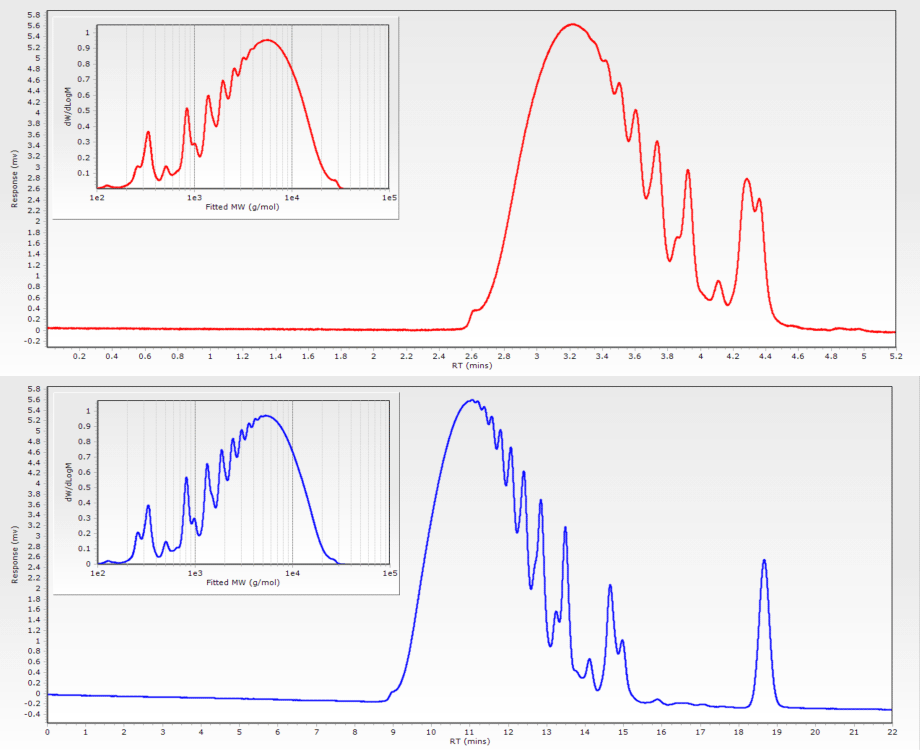Access Agilent eNewsletter, July 2013
>> Update My Profile | Subscribe to Access Agilent | Article Directory

Reduce GPC analysis time while maintaining analysis integrity
By Ben MacCreath
Agilent Product Manager, GPC/SEC Instrumentation
 Enlarge
Enlarge
Figure 1. Agilent PlusPore columns overcome artifacts like these dislocations, which result from a mismatch of the pore volumes of components in a blended column.
The primary goal of gel permeation/size exclusion chromatography (GPC/SEC) is to ascertain the molecular weight distribution of a sample, so achieving a true representation is critical. A common problem in GPC/SEC is choosing a column set to cover the entire molecular weight range. Selecting individual pore-size columns whose pore volumes are not close enough will leave gaps in the resolution range; conversely, choosing ones that are too close can cause dislocations. Dislocations are caused by an overlap in resolving range between the different columns and they cause uncertainty. (See Figure 1.) Is the dislocation caused by the columns or is it a true representation of the sample? Because these overlaps go beyond the column range specifications, batch-to-batch reproducibility is extremely unlikely if dislocations or gaps are apparent.
Use Agilent PlusPore to avoid dislocations
The Agilent PlusPore GPC column family is unique in its ability to guarantee no dislocations across a wide range of solvents, so you can easily change from solvent to solvent. These polymeric GPC columns use a proven and long-established technology, released in 2004 as the next-generation GPC/SEC columns. They use one particle size with multiple pores, which eliminates gaps and dislocations. Polymeric columns are robust and are better matched to the polarity of your analytes, delivering fewer interactions.
Although traditionally GPC/SEC is performed at 1.0 mL/min on 7.5 × 300 mm columns, large pore volume and bed-stability allow you to achieve quicker flow rates. Large pore volume and bed-stability have been utilized with a range of Agilent columns, including PL Rapide columns.
However, if you also require reduced solvent consumption, then a smaller column dimension is better suited. For the separation to perform as well with a 4.6 mm inside diameter (id) column as a 7.5 mm id column, you must minimize dispersion. The Agilent 1200 Infinity Series leads the market in low dispersion systems, from the affordable, fully integrated 1220 Infinity LC to the 1290 Infinity LC for ultra high performance liquid chromatography (UHPLC).
 Enlarge
Enlarge
Figure 2. Method transfer from standard speed (bottom) to rapid GPC (top). Note that the time scale is 22 min for the bottom chromatogram and 5 min for the top.
Use Agilent MesoPore for optimal results with prepolymers
MesoPore columns were specifically designed to give high-resolution analyses of low-molecular-weight polymers. We recently demonstrated use of Agilent MesoPore 4.6 × 250 mm columns for the fast analysis of low-molecular-weight oligomers and resins on an Agilent 1260 Infinity GPC/SEC System operated with Agilent GPC/SEC software.
Figure 2 shows a resin analyzed at standard GPC/SEC conditions. We then increased the flow rate four-fold to produce excellent results in less than five minutes with minimal loss in resolution.
Transfer methods the easy way
Method transfer to the Agilent 1220 Infinity LC is easy because polymeric columns generate low pressures – much below the maximum operating capabilities of these UHPLC systems. You can use smaller id columns and obtain the same results, saving solvent in the process. The 1200 Infinity Series has minimal dispersion and even better, you can upgrade the same instrument and columns to multi-detector GPC with the Agilent 1260 Infinity Multi-Detector GPC/SEC System. This system incorporates refractive index (RI), viscometry, and light-scattering detectors – when you want complete characterization of your polymer samples.
To find a solution for your GPC/SEC requirements, as well as valuable GPC resources including application compendia, selection guides, primers and more, visit our GPC solutions page.
>> Update My Profile | Subscribe to Access Agilent | Article Directory
Figure 1.

Agilent PlusPore columns overcome artifacts like these dislocations, which result from a mismatch of the pore volumes of components in a blended column.
Figure 2.

Conditions for GPC analyses |
|
|---|---|
Instrument |
Agilent 1260 Infinity GPC/SEC System |
Column set |
2 × Agilent MesoPore, 4.6 × 250 mm |
Eluent |
Tetrahydrofuran (THF) |
Flow rate and pressure |
0.3 mL/min at 50 bar and 1.2 mL/min at 170 bar |
Chromatography data system |
Agilent GPC/SEC software |
Method transfer from standard speed (bottom) to rapid GPC (top). Note that the time scale is 22 min for the bottom chromatogram and 5 min for the top.